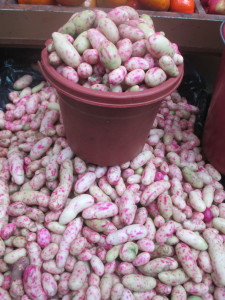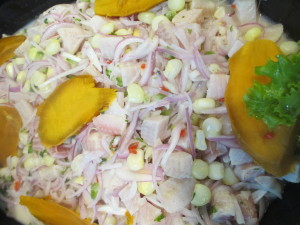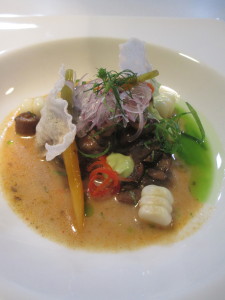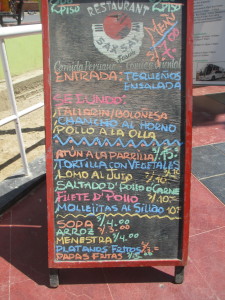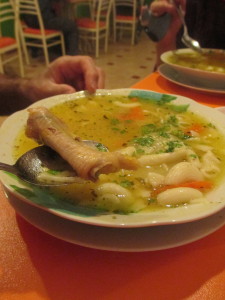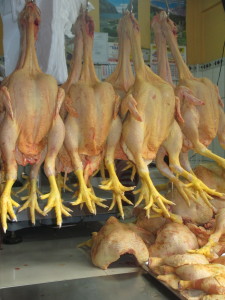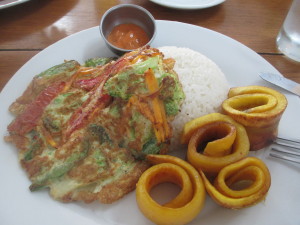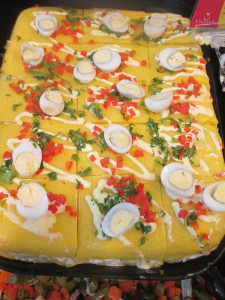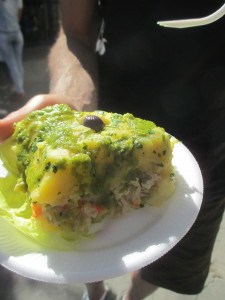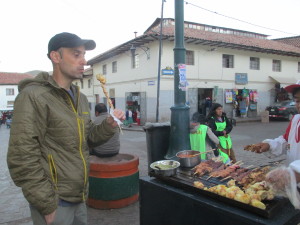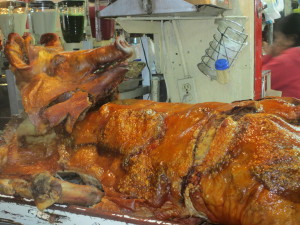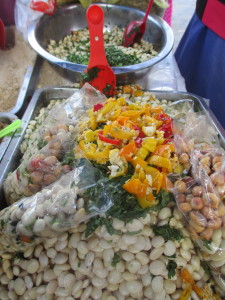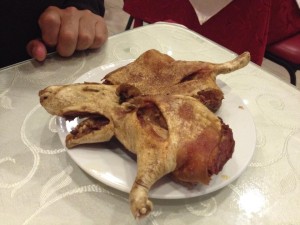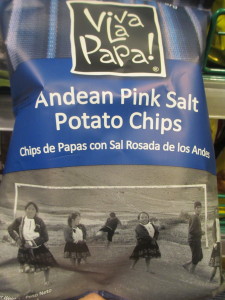Many of you have inquired over the past number of months about what we’ve been eating in South America. Truth be told, the food hasn’t really been, in my opinion, worth writing home about. Then we came to Peru. Ask anyone who’s traveled to SA and they will agree that the food in Peru wins the “Best Food in South America” prize.
My editor (you know that’s Harry, right?) wants to make sure we don’t insult anyone’s national cuisine by making it clear that we are not foodies, and we are traveling on a backpacker budget. We do not seek out the best restaurants and top chefs wherever we go. In fact, our preference is to eat simply and frequent local restaurants, food stalls and street vendors. Luckily for us, much of Peru’s food, regardless of where it’s purchased, is tasty.
Pass the Potatoes + Quinoa, Please
Peru is proud of their potatoes. Thanks to the resourcefulness of the Incas and their high-altitude farming practices, we’ve heard there are between 3,800 and 5,000 varieties grown in Peru. While you might only see a few types at the market, many family farms are growing their own variety for their personal consumption. Some are exceptionally lovely looking while most just look like, well, potatoes. But they all have one thing in common: they are meant to be eaten, and rest assured, one eats a lot of potatoes in Peru!
Quinoa is another staple in the Peruvian diet. One of the few plant-based sources of complete protein, quinoa is also grown in the high Andes and can be found in many soups and dishes. Street vendors cook it up with apples, blend it with water and serve it hot as a hearty breakfast drink.
Over the years quinoa has become increasingly popular in the US and Europe. Ever notice how expensive it is? That’s party because it’s difficult to harvest and partly because it only grows in the high altitude region of the Andes in Peru and Bolivia. The cost of quinoa has risen so much that many locals cannot afford to eat it anymore. Guess what they’re eating instead? Imported white rice. This issue has received a lot of press lately so if you’re interested, please read more about it. A field of quinoa is pictured below.
Ceviche
Ceviche is a very popular dish that is sold all over Peru in both restaurants and on street corners (we are not recommending this option! Duh). Peruvians will tell you that they invented this refreshing dish. While I don’t eat seafood I can certainly appreciate how beautiful ceviche looks. Harry ate enough for both of us. While we were in Lima we had a fancy dining experience at Bistro 1087 and I was served delicious vegetarian ceviche. Tip of the day: if you want to eat ceviche you’ll need to go to a ‘cevicheria’ for lunch when the fish is fresh. You won’t find this dish for dinner.
Menu Of The Day
In Argentina Harry fell in love with the “Plate of the Day” concept where one can buy a set meal for lunch for a low price. Harry’s been as pleased as punch to find that the same practice holds true all over the countries we’ve visited. In Peru the value meal is called the “Menu of the Day”, and it always starts out with a bowl of soup. If I’ve said it once, I’ve it a million times: Peruvians love their soup! The warm bowls of goodness are generally made with noodles or quinoa and some kind of meat. One can choose from a few options for the main course, like chicken or seafood with rice or potatoes. A fresh glass of fruit juice is served as well. You can get all of this for as low as $2.40. Restaurants have sign boards that sit on the sidewalk advertising the day’s menu.
Here’s a picture of Harry’s soup with a chicken foot (sans toes) in it. He politely tucked the foot on the side of his plate and finished his soup.
I Got Lucky on the Coast
I found the best Menu of the Day I’ve ever had on our second to last day in Peru. We were in Mancora on the Pacific Ocean in northern Peru. The “tortilla con vegetales” (egg fritter with veggies) was full of vegetables like peas and peppers. I was served rice, of course, and a side of lightly fried plantains creatively rolled up in style. The “aji” (homemade hot sauce) was flavorful and spicy. My meal was so good I just had to eat there the next day as well. It was the perfect last meal on our final day in Peru.
“Causa rellena” is a typical dish made with layers of potatoes topped with hard boiled eggs. Chicken or seafood salads and olives are often found inside.
Street Food + Local Markets
Many people get nervous when they hear the words ‘street food’, but really there’s nothing to worry about. Ha! Well, that’s not exactly true. As long as you’re careful and only eat food from a clean source you shouldn’t have (m)any problems. I was so happy to find some street food that I could eat: potatoes, boiled eggs and hot salsa. Harry likes to eat grilled meat on-a-stick, even when he’s not sure what kind of meat it is. Eating raw vegetables is usually not a good idea, even when served in a restaurant because you never know if they’ve been washed with purified water or not.
Yes, that pig’s head was put back on the body, backwards. Fancy.
Guinea Pig: It’s What’s For Dinner
This section is dedicated to my brother David who has been begging Harry to try guinea pig for dinner. Yes, you heard me right — guinea pig! A delicacy in Peru, this cute, furry rodent called “cuy” is either fried or roasted (sometimes over a spit) and served with its head and legs intact. It’s a pretty expensive dish and many locals can’t afford to eat it on a regular basis.
The question of the day among travelers is always, “Have you tried cuy yet?” and as you can imagine, there are two passionate answers to this question. Even though I had a pet guinea pig as a child (RIP, Gunther), I, too, was rooting for Harry to sample this unique dish, but he stood his ground. While he does like to be adventurous, he draws the line at the rodent family.
*The following photos are not for the faint of heart.* Walking around markets one can find cages of live guinea pigs so you can choose the one you want to eat. Or you can buy one already prepared for cooking, skinned and splayed open for display. Aren’t their little organs cute? Since Harry wouldn’t order guinea pig I had to borrow the cooked cuy photo from our Australian friend Adrian. So…. close your eyes if you are nervous about seeing the following images…
Salty Snacks
It wouldn’t be nice of me to end this post with those pictures, so let’s talk about potato chips for a minute. After all, you know me — I love me some salty snacks. But South Americans? Not so much. While one can always buy potato chips in tiendas (little markets), there aren’t a lot of options to chose from and you can always count on the imported brands (namely Lays and Doritos) being really expensive. Plus, who wants to eat American brands while in South America?
With that said, we’ve come across a brand of chips called “Viva La Papa!” in bigger grocery stores. I love everything about this brand. Look at the packaging — so pretty with indigenous fabric stripes on the tops of each bag. The photos are great — do you see the kids on a soccer field on the blue bag? And the indigenous faces on the other bags? The flavor of the blue bag is “Andean Pink Salt”. You might remember that we visited the salt factory in the Sacred Valley near Cusco and saw how the locals harvest that same salt.
These chips are a special treat because they are expensive, but sometimes we just can’t resist. There may be 5,000 types of potatoes in Peru, but for me the potato chip takes the cake.

